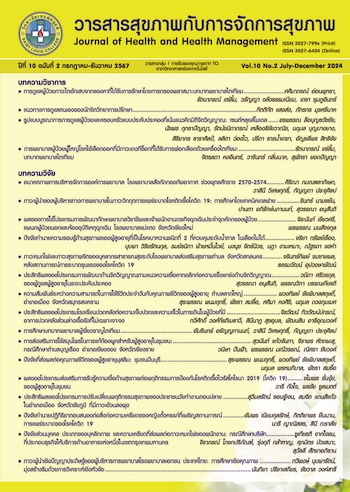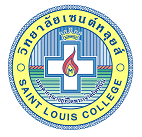A Scenario of Nursing Organization Management Royal Thai Air Force Hospital During A.D. 2027-2031
Keywords:
Nursing Organization Management, Scenario of Royal Thai Air Force HospitalAbstract
The purpose of this descriptive research was to study a scenario of nursing organization management at Royal Thai Airforce hospital during A.D.2027-2031. The Delphi technique was used in this study. Key informants were 18 experts in nursing organization management at Royal Thai Air Force Hospital. The process of conducting research consists of three steps. In step one, all experts were interviewed about nursing organization management. In step two, interviewed data were analyzed to develop a questionnaire, which was then sent to the same experts to gather their opinions on the likelihood of future scenarios based on each question. In step three, the data were analyzed for median and interquartile range, and the results were sent back to the experts for confirmation of their opinions. The result scenario of nursing organization management at Royal Thai Air Force Hospital during A.D.2027-2031 consists of 7 components as follows: 1) Organizational management planning 2) Nursing service 3) Knowledge and information technology management 4) Innovation and quality improvement 5) Human resource management 6) Educational management and 7) Preparedness for Military Medical Missions, Emergency Response and Disaster Management. The research findings suggest that the future scenario of nursing organization management at Royal Thai Air Force Hospital during A.D. 2027-2031 should focus on developing seven key areas. This serves as a guideline for nursing administrators in planning and formulating management policies for nursing organizations in Royal Thai Air Force hospitals to ensure continued efficiency.
References
กรมป้องกันและบรรเทาสาธารณภัย. (2567). สถิติสถานการณ์สาธารณภัยของประเทศไทย ประจำปี 2567. สืบค้น 30 พฤษภาคม 2567 จาก https://dpmreporter.disaster.go.th/portal/disaster-statistics
คชาภรณ์ ผันผาย, และปริญญาภรณ์ พจน์อริยะ. (2561). การจัดการความรู้โดยใช้เทคโนโลยีเพื่อประสิทธิภาพการปฏิบัติงานของพนักงานบริษัทเอกชนในพื้นที่กรุงเทพมหานคร (สารนิพนธ์ปริญญามหาบัณฑิต) กรุงเทพฯ: มหาวิทยาลัยรามคำแหง.
จันทนา โปรยเงิน, และแสงจันทร์ สุนันต๊ะ. (2561). การพัฒนาศักยภาพการสอนสำหรับพยาบาลพี่เลี้ยง วิทยาลัยพยาบาลกองทัพบก. วารสารพยาบาลทหารบก, 19(3), 38-43.
ณัฐวัชร จันทโรธรณ์. (2562). ยุทธศาสตร์การบริหารจัดการองค์การสมัยใหม่. วารสารครุศาสตร์อุตสาหกรรม มหาวิทยาลัยเทคโนโลยีราชมงคลธัญบุรี, 7(2), 60-70.
นิตยา คล่องขยัน. (2566). การพัฒนารูปแบบบริการงานผู้ป่วยนอกด้วยกระบวนการ Smart Hospital โรงพยาบาลพรเจริญ จังหวัดบึงกาฬ. สืบค้นจาก https://bit.ly/3WKbIkF
นิตยา ถนอมศักดิ์ศรี. (2562). ปัจจัยที่มีอิทธิพลต่อผลการดำเนินงานด้านนวัตกรรมในองค์กรพยาบาลตามการรับรู้ของหัวหน้างานการพยาบาลในโรงพยาบาลชุมชน สังกัดกระทรวงสาธารณสุข (วิทยานิพนธ์ปริญญาดุษฎีบัณฑิต) นครปฐม: มหาวิทยาลัยคริสเตียน.
บุญใจ ศรีสถิตย์นรากูร. (2553). ระเบียบวิธีการวิจัยทางการพยาบาลศาสตร์ (พิมพ์ครั้งที่ 5). กรุงเทพฯ: โรงพิมพ์จุฬาลงกรณ์มหาวิทยาลัย.
พิชา คนกาญจน์. (2564). ผู้นำและการจัดการทางการพยาบาลใหม่. วารสารโรงพยาบาลวสิงห์บุรี, 30(1), 15-23.
ภารดี ชาวนรินทร์ และคณะ. (2564). ซอล์ฟสกิล : ทักษะที่จำเป็นสำหรับวิชาชีพพยาบาล. วารสารวิชาการสุขภาพภาคเหนือ, 9(1), 1-17.
มัทนิน พฤติธนาภัทร, ชมสุภัค ครุฑกะ, และดวงเดือน จันทร์เจริญ. (2565). โปรแกรมฝึกอบรมออนไลน์เพื่อเสริมสร้างสมรรถนะทางการบริหารของผู้บริหารการพยาบาลระดับต้นธุรกิจดูแลสุขภาพภาคเอกชน. วารสารบัณฑิตวิทยาลัย มหาวิทยาลัยรามคำแหง ฉบับเทคโนโลยีการศึกษา, 6(1), 15-25.
ยุทธพล ผ่องผลีศาล. (2561). การส่งเสริมประสิทธิภาพการบริหารงานวิจัยตามยุทธศาสตร์องค์กร: กรณีศึกษา คณะสิ่งแวดล้อมและทรัพยากรศาสตร์ มหาวิทยาลัยมหิดล. วารสารวิจัยและพัฒนาวไลยอลงกรณ์ ในพระบรมราชูปถัมภ์, 13(3), 1-11.
วัชราพร ดวงแก้ว, ทองเหรียญ มูลชีพ, และอัญชลี ศรีสุตา. (2566). การพัฒนากลยุทธ์การเสริมสร้างความผูกพันต่อองค์กรพยาบาล โรงพยาบาลลำพูน. วารสารโรงพยาบาลแพร่, 31(1), 1-15.
วินุลาศ เจริญชัย, นพคุณ คุณาชีวะ, บุศรา นิยมเวช, และสัญญา เคณาภูมิ. (2565). การสังเคราะห์องค์ประกอบองค์การสมรรถนะสูง. Journal of Modern Learning Development, 7(2), 438-454.
ศิริชัย กาญจนวาสี. (2555). สถิติประยุกต์สำหรับการวิจัย. กรุงเทพฯ: โรงพิมพ์แห่งจุฬาลงกรณ์มหาวิทยาลัย.
สภาการพยาบาล. (2565). แผนกลยุทธ์การพยาบาลและการผดุงครรภ์ พ.ศ.2565-2569. กรุงเทพฯ: สำนักพิมพ์สื่อตะวัน จำกัด.
Johnson, G., Scholes, K., & Whittington, R. (2008). Exploring Corporate Strategy (8thEd). Essex: Pearson Education Limited.
Linstone, H.A. & Turoff, M. (1975). The Delphi method: Technique and application. MA: Addison-Wesley.
Macmillan, T.T. (1971). The delphi technique. Retrieved from https://files.eric.ed.gov/fulltext/ED064302.pdf
National League for Nursing (NLN). (2016). The NLN Nursing Education Research Priorities. Retrieved from https://www.nln.org/docs/default-source/uploadedfiles/about/nln-vision-series-position-statements/a-vision-for-advancing-thescience.pdf?sfvrsn=9565a90d_0
Patel, S. (2021). Soft Skills for Health Care Staff: A Scoping Review. Retrieved from https://www.theseus.fi/bitstream/handle/10024/501945/Patel%20Shradhdhabahen.pdf?s
Thomas, J.P & Robert, H.W. (1982). In Search of Excellence: Lessons from America’s Best-Run Companies. New York: Harper & Row.
Thomas, H. (2007). An analysis of the environment and competitive dynamics of management education. Journal of Management Development, 26(1), 9-21.
Downloads
Published
How to Cite
Issue
Section
License
Copyright (c) 2024 Journal of health and health management

This work is licensed under a Creative Commons Attribution-NonCommercial-NoDerivatives 4.0 International License.




